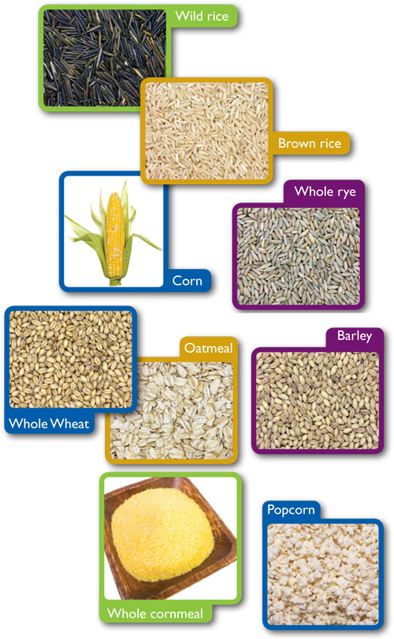
As we head into Summertime here in the Northern Hemisphere, we tend to focus more on the growing season for fruits, herbs, and vegetables that often have increased availability from local sources during our warmer weather months.
Nonetheless, we shouldn’t forget about another key fuel source–carbohydrates–preferably coming from whole grains.
(Image of Whole Grains courtesy of VA Cooperative Extension)
This past May, Whole Grains Summit 2012 was hosted by the University of Minnesota in conjunction with the Grains for Health Foundation and a large number of Sponsors and Partners, bringing together stakeholders from far and wide to weigh in on their perspectives on the issues surrounding global whole grain availability & consumption. There was an opportunity to network and to share viewpoints concerning “research, regulatory, and/or consumer landscape[s] as it relates to whole grains.”
Attendees wanted to zero in on what can be done to increase availability of whole grains to the consumer. What would follow next is to address increasing consumer awareness of whole grains and ultimately increasing consumer consumption of whole grains, and focusing on what areas of research concerning grain consumption overall deserve more attention globally. As with the previous Summits, the pdf of the abstracts, etc., can be found on the www.
We know that the incidence of obesity and non-communicable chronic diseases (NCDs) is on the rise.
As Noel Mueller of the Univ of MN noted, “whole-grain foods contain ample fibers, resistant starches, vitamins, minerals, phytoestrogens, and antioxidants that may protect against NCDs”…He additionally noted that epidemiologically, …”most studies [suggest] diets rich in whole-grains are inversely associated with risk of type 2 diabetes, cardiovascular diseases, and cancer.”
Now a number of whole grains are rich in gluten, which means those with celiac disease or non-celiac gluten sensitivity have to be alert to avoiding anything containing enough allergen parts per million (ppm) to protect their health, but luckily it doesn’t mean that they have to give up all whole grains–just some of them. They have to avoid cross-contaminated oat sources, as well as any wheat, rye, or barley sources. Gluten-free oat options exist and you can find details concerning those in a previous blog post.
Some individuals either experience an allergic reaction to or are otherwise sensitive to the proteins involved in gluten formation and must focus in on living as gluten-free as possible. Joseph Murray of the Mayo Clinic in Rochester MN noted that “There has been a substantial, almost five-fold increase in the true prevalence of celiac disease over the last 50 years, now affecting all ages.” He went on to comment that “While we know that gluten and certain common genetic variants are required to get celiac disease, we do not understand why the disease has been increasing and how it can occur in individuals who have seemingly tolerated gluten-containing foods for decades before developing the disease.”
Addressing more details concerning celiac disease and non-celiac gluten sensitivity is beyond the scope of this particular blog post, but we do have other blog posts on this site addressing the subject.
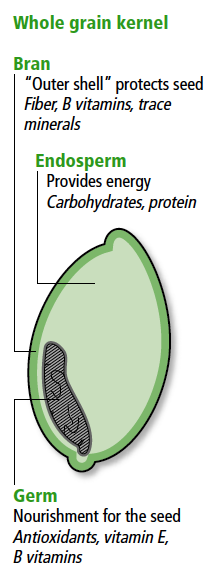 What differentiates a whole grain from a refined grain and why does that matter so much?
What differentiates a whole grain from a refined grain and why does that matter so much?
(Whole Grain Kernel diagram courtesy of USDA Home and Garden Bulletin No. 267-2 aka Get on the Grain Train)
Whole grains contain the entire grain kernel—the bran, germ, and endosperm.
Since whole grains have NOT been stripped of the bran, they remain rich in fiber and also contain important antioxidants, B vitamins, as well as minerals such as copper, iron, magnesium, and zinc, etc. Whole grains also still have the germ, which contains important antioxidants, B vitamins, phytonutrients, healthy unsaturated fatty acids/fats, Vitamin E, etc.
Refined grains on the other hand are milled—meaning that BOTH the bran and the germ are removed. Although the endosperm contains small amounts of some minerals and vitamins, the main contributing sources of those nutrients have been stripped from refined grains via milling.
The milling process also removes a large portion of the B vitamins, iron, and dietary fiber, which is why some refined grains are then enriched.
Although the enrichment process can add back in certain levels of particular B vitamins (thiamin, riboflavin, niacin, folic acid) as well as iron after processing, fiber is not added back in to most enriched grain products.
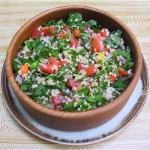 The Tabbouleh Salad (aka Tabouleh, Tabouli, Taboli, Taboule, etc.) recipe on the blog site earlier this week combined a nod to whole grains by including some bulgur wheat, along with that salad being composed of primarily some of our favorite summertime vegetables.
The Tabbouleh Salad (aka Tabouleh, Tabouli, Taboli, Taboule, etc.) recipe on the blog site earlier this week combined a nod to whole grains by including some bulgur wheat, along with that salad being composed of primarily some of our favorite summertime vegetables.
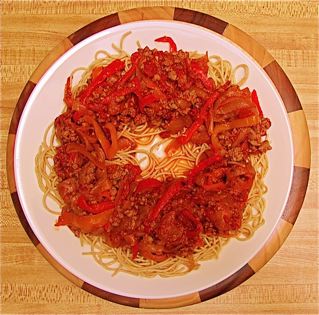 In warmer weather we also still eat some pasta products made from whole grains, so we look for the proper labels on the packages of the raw pasta.
In warmer weather we also still eat some pasta products made from whole grains, so we look for the proper labels on the packages of the raw pasta.
(Dinner plate image of homemade sauce featuring tomato paste, tomato puree, canned diced tomatoes, assorted spices and herbs, plus Vidallia and red onions, assorted red-yellow-orange sweet peppers, fresh slivered garlic, and extra-lean ground beef (home-ground from eye round)–all over a light bed of 51% whole grain thin spaghetti).
(Pasta Plate photo credit Stephanie B-H/SensoryNutrition/US12)
Any food items such as some pasta brands and types that bear a whole-grain health claim on the label must contain 51 percent or more whole grains by weight. The label will note whole durum wheat or whole semolina (meaning they are 49% or less by weight of refined wheat or refined semolina) and the product should be low in fat.
There are also 100% whole grain pastas, but they may be considered coarser +/or heavier and perhaps a bit gummy by some consumers.
Other pasta formulations are sold. To quote Mary Meck Higgins of Kansas State University from her publication Whole Grain Pasta “Multi-grain pasta may or may not be whole-grain. Some multigrain pasta brands contain whole durum wheat flour blended with other whole grains such as oats, barley and spelt. Pastas made from whole grain kamut, farro, brown rice, quinoa, corn and soba/buckwheat are also sold. Some pastas have non-grain ingredients, too, such as soy or other legumes.”
The 2010 Dietary Guidelines for Americans recommend “making half your grains whole” or eating three or more servings of whole grain foods daily. Whole grain pastas are higher in protein content (7-10 grams per 2 oz dry weight serving), as well as being higher in minerals, phytonutrients and vitamins than refined pastas are, plus they contain 2-3 x the fiber (5-7 grams per 2 oz dry weight servings) that refined pastas do.
As the Dietary Guidelines related materials suggest, some of the ways to increase your consumption of whole grains might include trying some of the following items:
- snack mix made from ready-to-eat, whole-grain cereals
- whole-grain (whole-wheat or oatmeal) muffin
- whole-grain bread or cracker crumbs in a meatloaf
- brown rice stuffing (cooked brown rice, onion, celery, and seasonings) in baked green peppers or tomatoes
- cookies made with some whole-grain flour or oatmeal
- whole-grain snack chip, such as baked tortilla chips
- brown rice or whole-wheat pasta
- whole grains in mixed dishes, such as pearl barley in vegetable soup and bulgur in casseroles or salads.
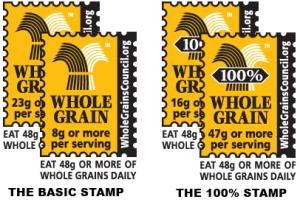 You can find a LOT of information concerning whole grains by simply checking out the website of the Whole Grains Council, including more about the point-of-purchase whole grain stamp program which we have mentioned in a previous blog post back on Dec 31, 2011, but which is well worth repeating. The “Basic Stamp” level means a food item contains at least 8 grams of whole grain per serving, but may also contain some refined grain as well; 16 grams of whole grains/serving is the minimum requirement for a 100% Whole Grain stamp–meaning ALL of the grain is whole grain.
You can find a LOT of information concerning whole grains by simply checking out the website of the Whole Grains Council, including more about the point-of-purchase whole grain stamp program which we have mentioned in a previous blog post back on Dec 31, 2011, but which is well worth repeating. The “Basic Stamp” level means a food item contains at least 8 grams of whole grain per serving, but may also contain some refined grain as well; 16 grams of whole grains/serving is the minimum requirement for a 100% Whole Grain stamp–meaning ALL of the grain is whole grain.
 There is even a newer restaurant symbol to look for when you’re dining out and are seeking whole grain options to choose from.
There is even a newer restaurant symbol to look for when you’re dining out and are seeking whole grain options to choose from.
(Whole Grain Stamps and Restaurant Symbol courtesy of Oldways and the Whole Grains Council and used here only for identification purposes).
The bottom line is there are many ways in which consumers, even those with food allergies +/or sensitivities, can access & incorporate more whole grains into their food style. All anyone has to do is just take that first step.

